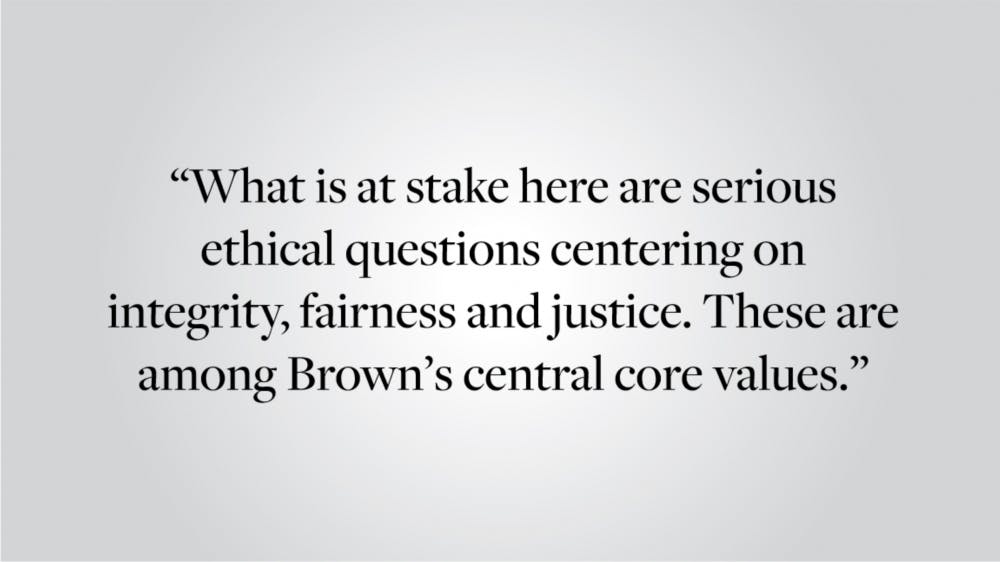The May 28 announcement arrived without warning — a thunderbolt from above, striking the hearts of legions within the University athletic community. The hand-picked Committee on Excellence in Athletics, composed of seven alumni and trustees chosen in part because of their “capacity to make very difficult recommendations in a fair and objective manner,” had done its work quietly. They worked off the recommendations of an external review group of consultants who claimed to have pinpointed the problem: too many varsity teams for the University’s limited resources. The Excellence Committee reached its recommendations through a process that lacked transparency and inclusion, thereby undermining the ethical obligations Brown has to its student-athletes.
The problem of achieving success for Brown athletics is far from new. It dates back to the first intercollegiate competition in 1859: a crew race with Yale and Harvard. Brown has been chasing them ever since, while also attempting to be competitive with the five other Ivy League schools. For myriad reasons, the Bears have served as the perpetual Ivy League underdogs, which, in a perverse way, makes Brown victory all the sweeter when it does come. To be sure, there have been outstanding individuals and teams, but sustained overall success across the spectrum of sports has proven elusive.
In spite of this history, Brown has always managed to field a large array of varsity teams, as well as robust non-varsity programs. It is somewhat of a miracle that Brown has been able to have the third greatest number of varsity sports nationally, given its position as the “poor cousin” in the Ivy League. In a sense, it is a badge of honor, as is the fact that Brown student-athletes consistently have the greatest academic success in the country.
The pressures to win, however, even at the Ivy level, have been dramatically ratcheting up in the last decade, and voices calling to address Brown’s problems have become louder. A decade ago, University President Ruth Simmons tackled the athletic conundrum. Her approach was an extensive and lengthy review of Brown athletics, headed up by a large and diverse Athletic Review Committee. The process was driven by a thorough examination of a wide range of factors, with data being just one of the rubrics. The initial result included the recommendation that four varsity teams — Wrestling, Women’s Skiing and Men’s and Women’s Fencing — be eliminated. But when the dust finally settled, all four teams were retained.
What separates the Simmons initiative from the current investigation was its adherence to Brown’s time-honored principles of inclusion, transparency and openness. Throughout the decision-making process in 2011, the flow of information to the Brown Community was extensive and detailed. As Simmons put it in her June 6, 2011 Letter to the Community: “A thorough process of review and decision-making in which the many points of view are weighed, while unusual and occasionally quite cumbersome, reflects well the spirit of this community that we cherish.” Over the summer and fall, Simmons met with representatives of the sports recommended for elimination.
In stark contrast, the Excellence in Athletics Initiative presents only a brief summary and includes no report from the Committee or its predecessor group. The net result is that the entire process seems heavy-handed. In fairness, it must be said that the Simmons Report was widely criticized for its reduction of athletic slots, some of which have been restored by President Paxson. Regardless, the Simmons Report was a case study in thoroughness and inclusion.
The University only added insult to injury with its timing of the report’s release — it could not have been worse. Brown students have endured a traumatic end of their academic year, separated from all semblance of normalcy. The pandemic and now the protests of racial injustice sweeping the country are ongoing major stressors, not to mention the uncertainty surrounding the forthcoming decision regarding the beginning of the academic year. Meanwhile, Brown is asking the impacted undergraduates and their families to make major life decisions such as transferring or staying at Brown (which would mean stay, but no play), while they are dealing with the loss of their Brown athletic identities. These student-athletes have given unstintingly of their time and talent to represent Brown; they deserve better treatment. The established bond of mutual trust with their college has been broken, with no opportunity offered to defend themselves against this decision.
An additional dimension adds further anxiety to the scenario: High school graduates who have been recruited by University coaches and who have committed to Brown are now left dangling, many with no options to continue their sports elsewhere if they decide not to attend Brown sans sports. At a minimum, Brown’s reputation will certainly be tarnished.
Given this unprecedented context, both external and Brown-created, the best course of action is for Brown to immediately suspend the recommendations of the Excellence Initiative. What is at stake here are serious ethical questions centering on integrity, fairness and justice. These are among Brown’s central core values.
In their recent message to the community, University administrators addressed the topic of Racial Injustice, urging everyone to “continue to care for and support each other, especially in this time when we are apart.” That plea surely applies to all in the University community who are impacted by this momentous decision.
Ultimately, Brown needs to achieve Victory with Honor!
Peter Mackie ’59 is a University sports archivist. He can be reached at peter_mackie@brown.edu. Please send responses to this opinion to letters@browndailyherald.com and op-eds to opinions@browndailyherald.com.

ADVERTISEMENT




